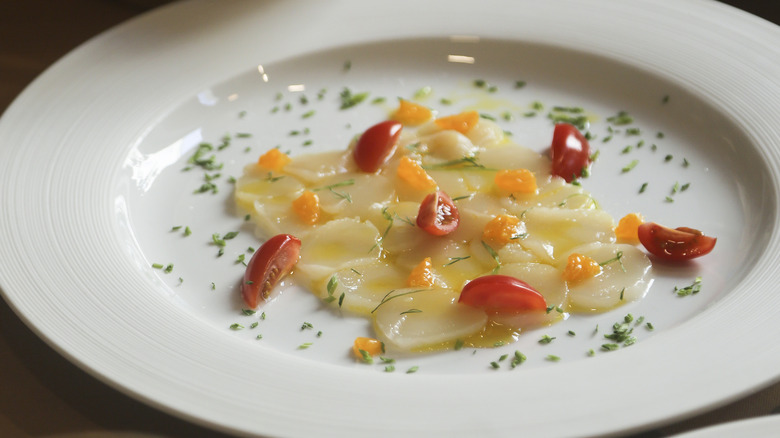Wary Of Raw Scallops? Scott Conant's Seasoning Tips Will Make You A Believer
When done well, scallops can be creamy, briny, buttery, and delicious, but some home cooks have been burned by how easily the shellfish can overcook and become unpleasantly rubbery. And while there are solutions to these easily preventable mistakes that cause this tough, chewy outcome, serving raw scallops might just be the best and easiest way to enjoy these aquatic gems in their most delicate, naturally sweet state.
Of course, preparing raw seafood can also be a bit intimidating. Fortunately, Chowhound had a chance to chat with celebrity chef, restaurateur, and cookbook author Scott Conant during the 2024 Food Network New York City Wine and Food Festival in October, at which point he offered some simple seasoning advice that will inspire culinarians at any level to take on this challenge. Conant suggests serving raw scallops diced up and simply dressed with "some chive, olive oil, lemon juice, [and] sea salt." He added that you can level up and embellish with a some caviar, too, in which case, you may even opt to leave out the lemon juice. "You have that saltiness and brininess from the caviar," he said of this satisfying, elegant iteration.
Either way, Conant's combination of ingredients creates a balance of flavors that won't obstruct the essence of your carefully selected scallops. And coupled with a few easy-to-follow guidelines, this seasoning tip will allow your shellfish to really shine.
Prepping raw scallops for seasoning
There are prep tips you need to know for the hands-down best grilled scallops, but when it comes to the raw version you don't actually have to do much. If you'd prefer to go for a slightly different presentation than Scott Conant's diced suggestion, you can portion your scallops into symmetrical round slices (about ¼ inch thick), and fan them out on a plate before dressing. Beyond that, it helps to keep them nice and cold for optimal flavor.
If you're concerned about the safety of raw scallops, there are some purchasing tips to keep in mind that will help ensure freshness. You'll want to seek out pieces that have a pleasant, sweet smell, and avoid milky-looking scallops that have a fishy aroma. It's also best to source shellfish marked by the term "dry packed," which indicates that they'll be free of additives (this is why wet-pack scallops are never worth buying). Bay scallops may be on the small side for this kind of preparation, so keep an eye out for larger sea scallops instead. And while frozen versions can be useful for recipes in which your scallops are cooked, this process can compromise their delicate texture and make them less appealing for raw service.
"Once you have a scallop raw, particularly a super fresh scallop raw, it's really hard to eat a cooked scallop after that," Conant said. And after you prepare your own according to his easy seasoning tips, you may soon be spreading the raw scallop gospel, too.

